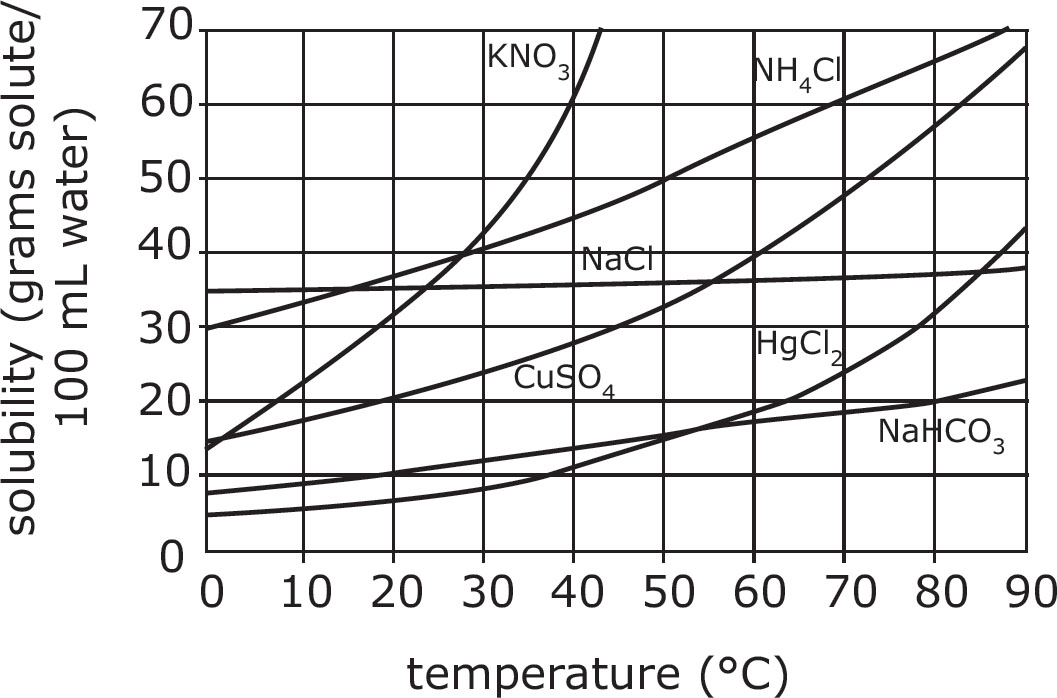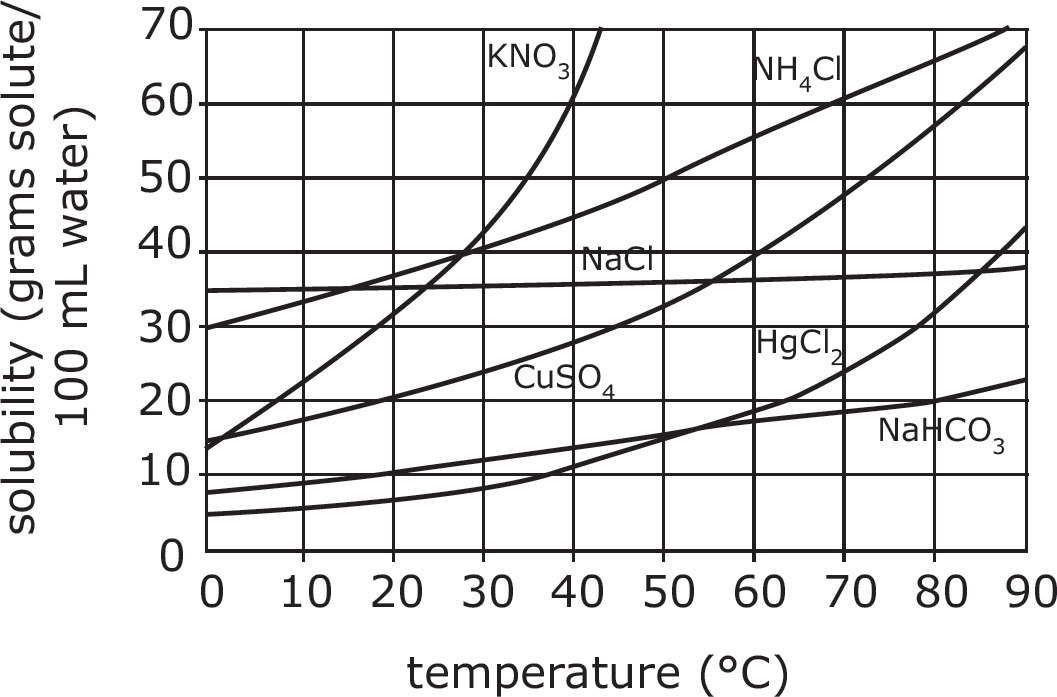
If you find that the idea of spending an hour and a half answering science questions sends you into a cold sweat, have no fear! While you will need to have some basic science knowledge in order to work the questions successfully, you won’t need to memorize the periodic table or learn how to do quantum physics. In fact, you’ll find that you can answer many of the questions in the Science test simply by reading the passages, charts, and graphs that the test provides, or by using scientific thinking. Some questions will require you to have outside knowledge, but in the chapters that follow we’ll address the topics that the test covers, so that you’ll be well prepared by the time that test day arrives.
To score well on the test, you first need to know what to expect on test day. On the GED® Science test you’ll have 90 minutes to answer approximately 34 questions, although the number of questions can vary slightly from test to test. The questions will come in six different formats.
Multiple-choice questions give you a question with four possible answers, and your job will be to choose the best answer. For example, you may see a passage-based multiple-choice question, such as the one that follows.
Biologists have long known that some types of electromagnetic radiation, such as X-rays and gamma rays, can be dangerous to human beings.
However, until now, no one has ever suggested that microwave radiation might also be harmful. In preliminary test-tube laboratory results, a scientist has found elevated growth rates in cancer cells exposed to low doses of microwaves.
These results are only preliminary because, first, there has been no controlled study of the effects of microwaves on human beings. Second, this study was of short duration, raising the possibility that the dangers of long-term exposure have not yet been assessed.
Although federal guidelines for how much electromagnetic energy can be allowed to enter the work and home environment have been made more stringent since they were first implemented in 1982, the recent study poses troubling questions about the safety of microwaves.
1.According to the information presented, the cancer cells’ increasing growth rates in the laboratory experiment was most likely due to
A. the cancer cells’ natural reproductive cycle.
B.a short-term growth spurt that may not indicate a general trend.
C.exposure to microwave radiation.
D.accidental contamination of cell samples during laboratory procedures.
Fill-in-the-blank questions won’t provide you with any answer choices; you’ll just need to fill a word or number into a blank space in order to answer the question. Note that if the question requires you to do any calculations, you will generally receive access to an online calculator. After all, the Science test is about understanding science concepts and scientific thinking, not your ability to do math! Here’s an example of a fill-in-the-blank question.
2.Each day for one week, doctors measured the flow rate—the amount of fluid passing through a given area of a pipe per second—of blood flowing through a patient’s aorta. The day of the week, the velocity of the blood, and the flow rate are shown in the chart below.
Day Blood Velocity Flow Rate Monday 40 cm/s 120 cm/s3 Tuesday 38 cm/s 114 cm/s3 Wednesday 39 cm/s 117 cm/s3 Thursday 42 cm/s 126 cm/s3 Friday 41 cm/s 123 cm/s3 Saturday 39 cm/s 117 cm/s3 Sunday 43 cm/s 129 cm/s3
What is the mean of the flow rates shown in the chart above?
You may use the calculator.

Drop-down menu questions are similar to multiple-choice questions, but you’ll need to choose your answers from a drop-down menu. Additionally, you may find that a single question will involve more than one drop-down menu. For example, you may see a question such as this one:
3.Scientists calculate the buoyant force, the upward force that a liquid exerts on an object submerged or floating in that liquid, by using the formula FB =ρfVg, where FB is the buoyant force,ρf is the density of the fluid, and g is a constant and is the acceleration due to gravity.
Based
on the information above, an object would experience a  in a
fluid that had
in a
fluid that had  .
.
Hot-spot questions will typically provide you with a chart or a graph, and ask you to identify a point on the chart or graph that answers a particular question. You’ll be able to select that point using your computer cursor. A typical hot-spot question might look like the following.
4.The term solubility refers to the amount of a substance (solute) that will dissolve in a given amount of a liquid substance (solvent). The solubility of solids in water varies with temperature. The graph below displays the water solubility curves for six crystalline solids.

Click the point on the graph at which the solubility of NaCl is equal to the solubility of CuSO4.
Drag-and-drop questions will provide you with multiple options, and you’ll be asked to select one or more of those options in order to complete the question. A typical drag-and-drop question may appear as follows.
5.The term solubility refers to the amount of a substance (solute) that will dissolve in a given amount of a liquid substance (solvent). The solubility of solids in water varies with temperature. The graph below displays the water solubility curves for six crystalline solids.

Identify the substances with the least change in solubility and the greatest change in solubility. Drag and drop your choices into the appropriate boxes.

Short-answer questions are short essay questions in which you’ll be asked to design an experiment, explain an issue, or answer a question. You should plan to spend about ten minutes answering each short-answer question, and you’ll see two of these questions per test. A typical short-answer question might be similar to the one below.
6.A marine biologist wishes to examine how the salt content in soil varies with distance from the ocean and with air temperature. She hypothesizes that, as the distance from the ocean increases, temperature increases and soil salt content decreases.
Design a controlled experiment that the biologist can use to determine whether her hypothesis is correct. Include a discussion of how she will collect data and how she will test her hypothesis.
Type your response on a computer, if one is available. Otherwise, write your response on paper. This task may require approximately 10 minutes to complete.
In addition to knowing the format in which the questions will appear, you should also know which skills those questions will test. Fortunately, GED® Science questions really test only a few skills. Once you master those skills, then you’ll find it much easier to ace the Science test!
Comprehension questions ask you to find a particular piece of information from a passage, chart, or graph, and then recognize that information, slightly restated, in an answer choice. Comprehension questions may also ask you to go just a bit further and identify a logical implication of that information. The question that follows is a comprehension question related to a passage you’ve already seen.

Biologists have long known that some types of electromagnetic radiation, such as X-rays and gamma rays, can be dangerous to human beings.
However, until now, no one has ever suggested that microwave radiation might also be harmful. In preliminary test-tube laboratory results, a scientist has found elevated growth rates in cancer cells exposed to low doses of microwaves.
These results are only preliminary because, first, there has been no controlled study of the effects of microwaves on human beings. Second, this study was of short duration, raising the possibility that the dangers of long-term exposure have not yet been assessed.
Although federal guidelines for how much electromagnetic energy can be allowed to enter the work and home environment have been made more stringent since they were first implemented in 1982, the recent study poses troubling questions about the safety of microwaves.
1.According to the information presented, the cancer cells’ increasing growth rates in the laboratory experiment was most likely due to
A. the cancer cells’ natural reproductive cycle.
B.a short-term growth spurt that may not indicate a general trend.
C.exposure to microwave radiation.
D.accidental contamination of cell samples during laboratory procedures.
Here’s How to Crack It
Before you begin the questions from any passage, you should always make sure that you understand the structure of the passage. For example, someone in a hurry might have read the first paragraph of this passage and gotten the impression that it was going to be about the danger of gamma rays and X-rays. However, if you looked past the first paragraph, you would realize that the introduction provides background historical context for the subject of the passage. It began by talking about the kind of rays scientists have “long known” to be dangerous and then segued in the second paragraph to another type of ray that may, it turns out now, be dangerous as well. The passage describes a laboratory study, gives two reasons that the results are only preliminary, and then summarizes. This question asks about a “laboratory experiment.” Where does the passage discuss a laboratory experiment? Check out paragraph 2. Briefly reread the paragraph, and then use Process of Elimination to remove answers that don’t agree with the information in the passage. The passage states that cancer cells exposed to microwave radiation experienced “elevated growth rates,” so the increasing growth rates are due to microwave radiation, and are not natural. Eliminate (A). While the passage does state that the effects of microwave radiation are unknown, it doesn’t provide any evidence that the growth spurt does not indicate a general trend, so (B) is incorrect. Choice (C) agrees with the passage, which states that “a scientist has found elevated growth rates in cancer cells exposed to low doses of microwaves.” Thus, (C) is the correct answer. The passage doesn’t mention accidental contamination, so (D) is not the correct answer.

Here’s another example of a comprehension question. It’s based on the same passage as the question on the previous page.
Scientists hypothesize that meteorologists who use remote sensing microwave radiometers to measure the temperature of objects and terrain may suffer adverse health effects due to frequent exposure to microwave radiation.
2.Which excerpt from the passage supports this hypothesis?
A. “These results are only preliminary, because, first, there has been no controlled study of the effects of microwaves on human beings.”
B.“Biologists have long known that some types of electromagnetic radiation, such as X-rays and gamma rays, can be dangerous to human beings.”
C.“A scientist has found elevated growth rates in cancer cells exposed to low doses of microwaves.”
D.“Federal guidelines for how much electromagnetic energy can be allowed to enter the home and work environment have been made more stringent since they were first implemented in 1982.”
Here’s How to Crack It
In this question, you’re asked about “adverse health effects due to frequent exposure to microwave radiation.” Where can you find information about possible adverse health effects caused by microwave radiation? Check out paragraph 2, and then use Process of Elimination to remove answer choices that don’t discuss adverse health effects and microwave radiation.
Choice (A) discusses the fact that there has been no controlled study of the effects of microwave radiation on humans. While this might suggest that the effects of microwave radiation on humans are unknown, it doesn’t show that meteorologists have cause for concern regarding their health; it merely shows that they don’t know whether they should be concerned. Thus, you can eliminate (A). Choice (B) does discuss the dangers of some types of electromagnetic radiation, but it discusses X-rays and gamma rays, rather than microwaves, so (B) is incorrect. Choice (C) mentions that microwaves may be associated with increased cancer cell growth rates, which is a potential health hazard associated with microwaves, and is the correct answer. Choice (D) discusses the fact that there are laws in place that regulate the amount of electromagnetic radiation allowed to enter homes and workplaces, but it does not deal specifically with microwave radiation, and does not state that the reason for such regulations is that such radiation poses a health hazard. Thus, (D) is also incorrect. The correct answer is (C).

To answer an application question, you must understand the meaning of a concept described in the passage and then apply that concept in a different context.
The following is an example of an application question.

1.Each day for one week, doctors measured the flow rate—the amount of fluid passing through a given area of a pipe per second—of blood flowing through a patient’s aorta. The day of the week, the velocity of the blood, and the flow rate are shown in the chart below.
Day Blood Velocity Flow Rate Monday 40 cm/s 120 cm/s3 Tuesday 38 cm/s 114 cm/s3 Wednesday 39 cm/s 117 cm/s3 Thursday 42 cm/s 126 cm/s3 Friday 41 cm/s 123 cm/s3 Saturday 39 cm/s 117 cm/s3 Sunday 43 cm/s 129 cm/s3
What is the mean of the flow rates shown in the chart above?
You may use the calculator.

Here’s How to Crack It
To find a mean, or average, you must add up all of the numbers given, and then divide your total by the number of numbers you added up. Be careful to make sure you’re solving for the correct thing; in this case, you want to find the mean of the flow rates, not the blood velocity, so be sure to use the numbers given for flow rate. In this case, adding up all of the numbers given for flow rate gives you 120 + 114 + 117 + 126 + 123 + 117 + 129 = 846. Divide 846 by 7 to get 120.86.

Here’s another application question.

2.A marine biologist wishes to examine how the salt content in soil varies with distance from the ocean and with air temperature. She hypothesizes that, as the distance from the ocean increases, temperature increases and soil salt content decreases.
Design a controlled experiment that the biologist can use to determine whether her hypothesis is correct. Include a discussion of how she will collect data and how she will test her hypothesis.
In a scientific experiment, the independent variable is the variable that is deliberately changed. The dependent variable changes as a result of changes in the dependent variable.
Source: Encyclopaedia Britannica, Inc.
Here’s How to Crack It
There are several possible ways that you might answer this question. However, start by considering what the biologist wants to test: “how the salt content in soil varies with distance from the ocean and with air temperature.” Since she wants to see the effect that distance has on temperature and salt content, she’ll want to get readings in which she varies distance. One way to do that might be as follows: She should collect soil samples at distances of 1 meter, 5 meters, 10 meters, 15 meters, 20 meters, and 25 meters from the ocean, and at each point she should also measure temperature. Keep in mind that experiments are concerned with both validity and reliability. Validity refers to whether or not a test measures what it is intended to measure and reliability refers to whether or not significant results are repeatable under identical conditions. Accordingly, the scientist must design the experiment with the goal of eliminating factors that could skew the results. In short, she needs to ensure she is accurately measuring the dependent variable by controlling for outside influences. To ensure that her results are accurate, she might repeat this process over several days; she would have multiple soil salt content and temperature results. She could then enter the data into a spreadsheet, and create two graphs: one that showed distance plotted against salt content, and another that showed distance plotted against temperature. If the biologist’s hypothesis is correct, then the plot of distance versus salt content should show a line or curve with an increasing trend, and the plot of distance versus temperature should show a line or curve with a decreasing trend.

Try this final application question.

3.Scientists calculate the buoyant force, the upward force that a liquid exerts on an object submerged or floating in that liquid, by using the formula FB = rfVg, where FB is the buoyant force, rf is the density of the fluid, and g is a constant and is the acceleration due to gravity.
Based
on the information above, an object would experience a  in a
fluid that had
in a
fluid that had 
Here’s How to Crack It
The passage states that g, the acceleration due to gravity, is a constant. Thus, you can eliminate “lesser acceleration due to gravity” from the answer choices in the first drop-down menu, since acceleration due to gravity does not change. Thus, the correct answer in the first drop-down menu must be “greater buoyant force.” Now check out the formula FB = rfVg. If density, or rf, increases, then FB, or the buoyant force, must also increase. On the other hand, if volume, or V, decreases, then FB must actually decrease. Thus, the correct answer in the second drop-down menu is “greater density.”

An analysis question asks you to break down information from a passage, chart, or graph into more specific categories, and then explore the relationships between those categories. An analysis question might be similar to this one.

1.The term solubility refers to the amount of a substance (solute) that will dissolve in a given amount of a liquid substance (solvent). The solubility of solids in water varies with temperature. The graph below displays the water solubility curves for six crystalline solids.

Identify the substances with the least change in solubility and the greatest change in solubility. Drag and drop your choices into the appropriate boxes.

Here’s How to Crack It
To find the substance with the least change in solubility, look at the slope of the graph of each of the substances. Note that NaCl has the flattest graph, which therefore means that it has the least change in solubility. The initial solubility of the substance is approximately 35 grams solute per 100 mL of water, and the final value is only approximately 38 grams solute per 100 mL of water. Thus, its change in solubility is very small. CuSO4 has an initial solubility of approximately 15 grams solute per 100 mL of water, and a final solubility of approximately 68 grams solute per 100 mL of water, and does not have the flattest graph, so it does not have the least change in solubility. NaHCO3 has an initial solubility of approximately 8 grams solute per 100 mL of water, and a final solubility of approximately 23 grams solute per 100 mL of water, and does not have the flattest graph, so it does not have the least change in solubility. Finally, HgCl2 has an initial solubility of approximately 5 grams solute per 100 mL of water, and a final solubility of approximately 43 grams solute per 100 mL of water, and does not have the flattest graph, so it does not have the least change in solubility. Note that of the substances, CuSO4 has the greatest difference between its initial solubility and its final solubility, and its graph has the steepest curve, so it is the substance with the greatest change in solubility.

To answer an evaluation question, you must make a judgment or prediction about the information provided in a passage, chart, or graph—sometimes by applying outside knowledge or information that you bring with you to the test.

Biologists have long known that some types of electromagnetic radiation, such as X-rays and gamma rays, can be dangerous to human beings.
However, until now, no one has ever suggested that microwave radiation might also be harmful. In preliminary test-tube laboratory results, a scientist has found elevated growth rates in cancer cells exposed to low doses of microwaves.
These results are only preliminary because, first, there has been no controlled study of the effects of microwaves on human beings. Second, this study was of short duration, raising the possibility that the dangers of long-term exposure have not yet been assessed.
Although federal guidelines for how much electromagnetic energy can be allowed to enter the work and home environment have been made more stringent since they were first implemented in 1982, the recent study poses troubling questions about the safety of microwaves.
2.Which of the following, if true, would lend weight to the scientists’ initial findings regarding microwaves?
I. Individuals who extensively use point-to-point telecommunications, which heavily utilize microwaves, have higher-than-average incidences of cancer.
II.A long-term study of cancer cells exposed to microwaves in the laboratory shows the same pattern of growth found in the short-term study.
III.A study of dental associates who regularly work with X-rays shows that such individuals have higher-than-normal incidences of cancer.
A. I only
B.II only
C.I and II
D.I and III
Here’s How to Crack It
One of the most useful things you can know for the GED® Science test is the scientific method. We will cover it in the review that begins in the next chapter, but for now, you should know that evaluation questions often ask you to bring some knowledge of the scientific method to bear on the question—and that is certainly the case here.
Given what the passage said about the preliminary nature of the study and what needs to be done next, which of the answer choices would help to prove the initial findings? The passage gave two reasons that the findings were only preliminary. First, the study was only at the test-tube stage. No studies involving people have been done yet. Second, it was only a short-term study. To know for sure if microwaves cause increased growth in cancer cells, a long-term study is needed.
Now check out the possibilities. Statement I addresses the first reason presented in the passage—as yet there has been no study on human beings—and provides you with a study that supports the initial findings with new findings on human subjects. Statement II addresses the second reason presented in the passage—there has been no long-term study as of yet—by providing information from a long-term study of cancer cells exposed to microwaves. Statement III, however, focuses on people who have been exposed to X-rays, rather than microwaves. Since this study does not relate to microwaves, the results would not lend any weight to the initial results described in the passage. Thus, I and II, but not III, support the initial results, and the correct answer is (C).

Here are the topics as they are described by the people who write the test:
Life Science: 40%
Physics and Chemistry: 40%
Earth and Space: 20%
If this list seems slightly vague, have no fear. While trying to acquaint yourself with all of the topics covered in a high school biology class might take a long time, you don’t need an in-depth knowledge of all of those topics in order to ace the Science test. In the chapters that follow, you’ll discover just exactly what information you will need.
While some questions won’t require you to have any particular knowledge of biology, earth science, physics, or chemistry, others will require you to have some general knowledge of these topics, including a knowledge of their specialized vocabularies. As you read, you’ll discover just exactly what basic knowledge of these subjects that you’ll need. You may even find that science is more fascinating than you imagined, and may want to learn more about these topics!